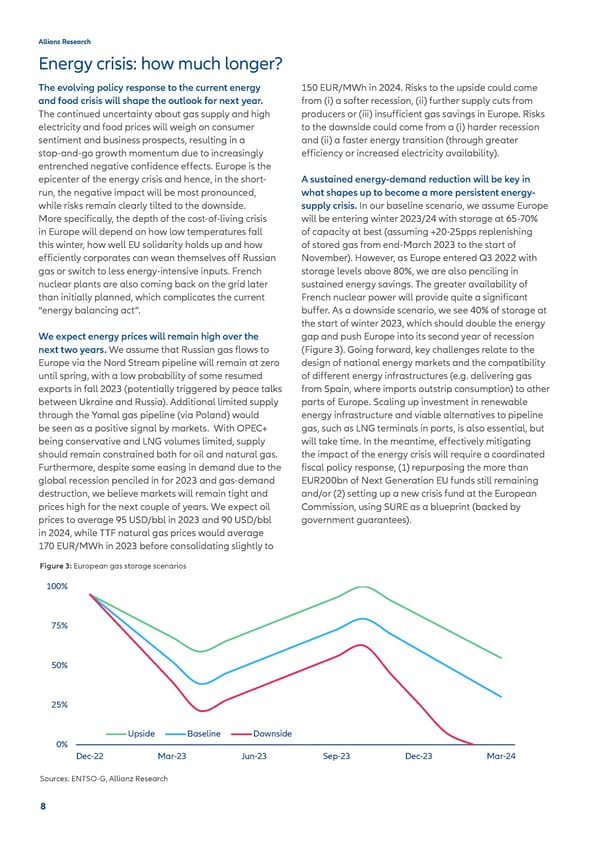Allianz Research Energy crisis: how much longer? The evolving policy response to the current energy 150 EUR/MWh in 2024. Risks to the upside could come and food crisis will shape the outlook for next year. from (i) a softer recession, (ii) further supply cuts from The continued uncertainty about gas supply and high producers or (iii) insufficient gas savings in Europe. Risks electricity and food prices will weigh on consumer to the downside could come from a (i) harder recession sentiment and business prospects, resulting in a and (ii) a faster energy transition (through greater stop-and-go growth momentum due to increasingly efficiency or increased electricity availability). entrenched negative confidence effects. Europe is the epicenter of the energy crisis and hence, in the short- A sustained energy-demand reduction will be key in run, the negative impact will be most pronounced, what shapes up to become a more persistent energy- while risks remain clearly tilted to the downside. supply crisis. In our baseline scenario, we assume Europe More specifically, the depth of the cost-of-living crisis will be entering winter 2023/24 with storage at 65-70% in Europe will depend on how low temperatures fall of capacity at best (assuming +20-25pps replenishing this winter, how well EU solidarity holds up and how of stored gas from end-March 2023 to the start of efficiently corporates can wean themselves off Russian November). However, as Europe entered Q3 2022 with gas or switch to less energy-intensive inputs. French storage levels above 80%, we are also penciling in nuclear plants are also coming back on the grid later sustained energy savings. The greater availability of than initially planned, which complicates the current French nuclear power will provide quite a significant “energy balancing act”. buffer. As a downside scenario, we see 40% of storage at the start of winter 2023, which should double the energy We expect energy prices will remain high over the gap and push Europe into its second year of recession next two years. We assume that Russian gas flows to (Figure 3). Going forward, key challenges relate to the Europe via the Nord Stream pipeline will remain at zero design of national energy markets and the compatibility until spring, with a low probability of some resumed of different energy infrastructures (e.g. delivering gas exports in fall 2023 (potentially triggered by peace talks from Spain, where imports outstrip consumption) to other between Ukraine and Russia). Additional limited supply parts of Europe. Scaling up investment in renewable through the Yamal gas pipeline (via Poland) would energy infrastructure and viable alternatives to pipeline be seen as a positive signal by markets. With OPEC+ gas, such as LNG terminals in ports, is also essential, but being conservative and LNG volumes limited, supply will take time. In the meantime, effectively mitigating should remain constrained both for oil and natural gas. the impact of the energy crisis will require a coordinated Furthermore, despite some easing in demand due to the fiscal policy response, (1) repurposing the more than global recession penciled in for 2023 and gas-demand EUR200bn of Next Generation EU funds still remaining destruction, we believe markets will remain tight and and/or (2) setting up a new crisis fund at the European prices high for the next couple of years. We expect oil Commission, using SURE as a blueprint (backed by prices to average 95 USD/bbl in 2023 and 90 USD/bbl government guarantees). in 2024, while TTF natural gas prices would average 170 EUR/MWh in 2023 before consolidating slightly to Figure 3: European gas storage scenarios 100% 75% 50% 25% Upside Baseline Downside 0% Dec-22 Mar-23 Jun-23 Sep-23 Dec-23 Mar-24 Sources: ENTSO-G, Allianz Research 8
 Allianz 2022 Outlook final Page 7 Page 9
Allianz 2022 Outlook final Page 7 Page 9